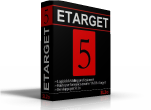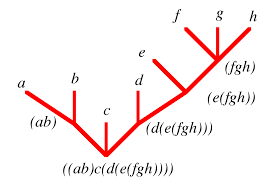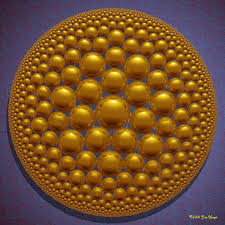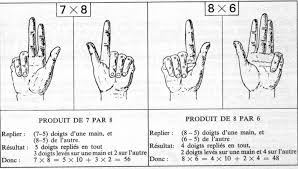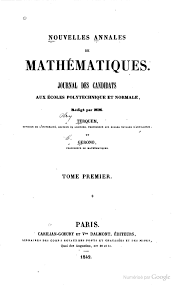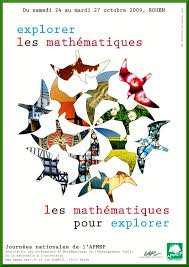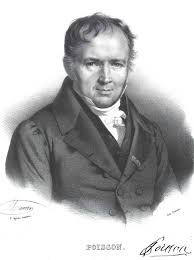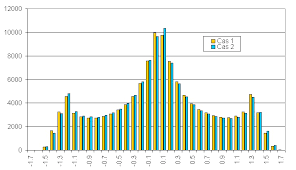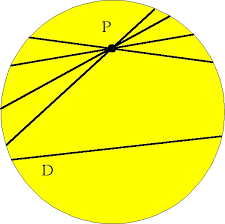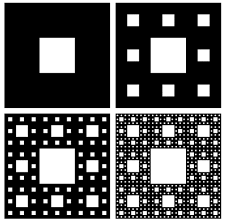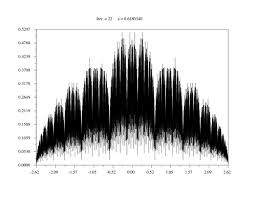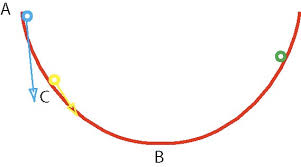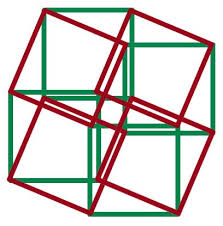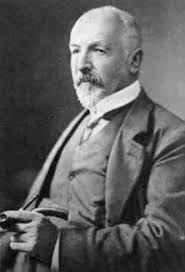21/05/2011
Arithmetic
Arithmetic
Arithmetic or arithmetics (from the Greek word ἀριθμός = number) is the oldest and most elementary branch of mathematics, used by almost everyone, for tasks ranging from simple day-to-day counting to advanced science and business calculations. It involves the study of quantity, especially as the result of combining numbers. In common usage, it refers to the simpler properties when using the traditional operations ofaddition, subtraction, multiplication and division with smaller values of numbers. Professional mathematicians sometimes use the term (higher) arithmetic[1] when referring to more advanced results related to number theory, but this should not be confused with elementary arithmetic.
Contents[hide] |
[edit]History
The prehistory of arithmetic is limited to a very small number of small artifacts which may indicate conception of addition and subtraction, the best-known being the Ishango bone fromcentral Africa, dating from somewhere between 20,000 and 18,000 BC although its interpretation is disputed.[2]
The earliest written records indicate the Egyptians and Babylonians used all the elementary arithmetic operations as early as 2000 BC. These artifacts do not always reveal the specific process used for solving problems, but the characteristics of the particular numeral system strongly influence the complexity of the methods. The hieroglyphic system for Egyptian numerals, like the later Roman numerals, descended from tally marks used for counting. In both cases, this origin resulted in values that used a decimal base but did not includepositional notation. Although addition was generally straightforward, multiplication in Roman arithmetic required the assistance of a counting board to obtain the results.
Early number systems that included positional notation were not decimal, including the sexagesimal (base 60) system for Babylonian numerals and the vigesimal(base 20) system that defined Maya numerals. Because of this place-value concept, the ability to reuse the same digits for different values contributed to simpler and more efficient methods of calculation.
The continuous historical development of modern arithmetic starts with the Hellenistic civilization of ancient Greece, although it originated much later than the Babylonian and Egyptian examples. Prior to the works of Euclid around 300 BC, Greek studies in mathematics overlapped with philosophical and mystical beliefs. For example, Nicomachus summarized the viewpoint of the earlier Pythagorean approach to numbers, and their relationships to each other, in his Introduction to Arithmetic.
Greek numerals, derived from the hieratic Egyptian system, also lacked positional notation, and therefore imposed the same complexity on the basic operations of arithmetic. For example, the ancient mathematician Archimedes devoted his entire work The Sand Reckoner merely to devising a notation for a certain large integer.
The gradual development of Hindu-Arabic numerals independently devised the place-value concept and positional notation, which combined the simpler methods for computations with a decimal base and the use of a digit representing zero. This allowed the system to consistently represent both large and small integers. This approach eventually replaced all other systems. In the early 6th century AD, the Indian mathematician Aryabhata incorporated an existing version of this system in his work, and experimented with different notations. In the 7th century, Brahmagupta established the use of zero as a separate number and determined the results for multiplication, division, addition and subtraction of zero and all other numbers, except for the result of division by zero. His contemporary, the Syriac bishop Severus Sebokht described the excellence of this system as "...valuable methods of calculation which surpass description". The Arabs also learned this new method and called it hesab.
Although the Codex Vigilanus described an early form of Arabic numerals (omitting zero) by 976 AD, Fibonacci was primarily responsible for spreading their use throughout Europe after the publication of his book Liber Abaci in 1202. He considered the significance of this "new" representation of numbers, which he styled the "Method of the Indians" (Latin Modus Indorum), so fundamental that all related mathematical foundations, including the results of Pythagoras and the algorism describing the methods for performing actual calculations, were "almost a mistake" in comparison.
In the Middle Ages, arithmetic was one of the seven liberal arts taught in universities.
The flourishing of algebra in the medieval Islamic world and in Renaissance Europe was an outgrowth of the enormous simplification of computation through decimal notation.
Various types of tools exist to assist in numeric calculations. Examples include slide rules (for multiplication, division, and trigonometry) and nomographs in addition to the electricalcalculator.
[edit]Decimal arithmetic
Although decimal notation may conceptually describe any numerals from a system with a decimal base, it is commonly used exclusively for the written forms of numbers with Arabic numerals as the basic digits, especially when the numeral includes a decimal separator preceding a sequence of these digits to represent a fractional part of the number. In this common usage, the written form of the number implies the existence of positional notation. For example, 507.36 denotes 5 hundreds (102), plus 0 tens (101), plus 7 units (100), plus 3 tenths (10−1) plus 6 hundredths (10−2). The conception of zero as a number comparable to the other basic digits, and the corresponding definition of multiplication and addition with zero, is an essential part of this notation.
Algorism comprises all of the rules for performing arithmetic computations using this type of written numeral. For example, addition produces the sum of two arbitrary numbers. The result is calculated by the repeated addition of single digits from each number that occupies the same position, proceeding from right to left. An addition table with ten rows and ten columns displays all possible values for each sum. If an individual sum exceeds the value nine, the result is represented with two digits. The rightmost digit is the value for the current position, and the result for the subsequent addition of the digits to the left increases by the value of the second (leftmost) digit, which is always one. This adjustment is termed a carry of the value one.
The process for multiplying two arbitrary numbers is similar to the process for addition. A multiplication table with ten rows and ten columns lists the results for each pair of digits. If an individual product of a pair of digits exceeds nine, the carry adjustment increases the result of any subsequent multiplication from digits to the left by a value equal to the second (leftmost) digit, which is any value from one to eight (9 × 9 = 81). Additional steps define the final result.
Similar techniques exist for subtraction and division.
The creation of a correct process for multiplication relies on the relationship between values of adjacent digits. The value for any single digit in a numeral depends on its position. Also, each position to the left represents a value ten times larger than the position to the right. In mathematical terms, the exponent for the base of ten increases by one (to the left) or decreases by one (to the right). Therefore, the value for any arbitrary digit is multiplied by a value of the form 10n with integer n. The list of values corresponding to all possible positions for a single digit is written as {..., 102, 10, 1, 10−1, 10−2, ...}.
Repeated multiplication of any value in this list by ten produces another value in the list. In mathematical terminology, this characteristic is defined as closure, and the previous list is described as closed under multiplication. It is the basis for correctly finding the results of multiplication using the previous technique. This outcome is one example of the uses ofnumber theory.
[edit]Arithmetic operations
The basic arithmetic operations are addition, subtraction, multiplication and division, although this subject also includes more advanced operations, such as manipulations ofpercentages, square roots, exponentiation, and logarithmic functions. Arithmetic is performed according to an order of operations. Any set of objects upon which all four arithmetic operations (except division by zero) can be performed, and where these four operations obey the usual laws, is called a field.
[edit]Addition (+)
Addition is the basic operation of arithmetic. In its simplest form, addition combines two numbers, the addends or terms, into a single number, the sum of the numbers.
Adding more than two numbers can be viewed as repeated addition; this procedure is known as summation and includes ways to add infinitely many numbers in an infinite series; repeated addition of the number one is the most basic form of counting.
Addition is commutative and associative so the order the terms are added in does not matter. The identity element of addition (the additive identity) is 0, that is, adding zero to any number yields that same number. Also, the inverse element of addition (the additive inverse) is the opposite of any number, that is, adding the opposite of any number to the number itself yields the additive identity, 0. For example, the opposite of 7 is −7, so 7 + (−7) = 0.
Addition can be given geometrically as follows:
- If a and b are the lengths of two sticks, then if we place the sticks one after the other, the length of the stick thus formed is a + b.
[edit]Subtraction (−)
Subtraction is the opposite of addition. Subtraction finds the difference between two numbers, the minuend minus the subtrahend. If the minuend is larger than the subtrahend, the difference is positive; if the minuend is smaller than the subtrahend, the difference is negative; if they are equal, the difference is zero.
Subtraction is neither commutative nor associative. For that reason, it is often helpful to look at subtraction as addition of the minuend and the opposite of the subtrahend, that isa − b = a + (−b). When written as a sum, all the properties of addition hold.
There are several methods for calculating results, some of which are particularly advantageous to machine calculation. For example, digital computers employ the method of two's complement. Of great importance is the counting up method by which change is made. Suppose an amount P is given to pay the required amount Q, with P greater than Q. Rather than performing the subtraction P − Q and counting out that amount in change, money is counted out starting at Q and continuing until reaching P. Although the amount counted out must equal the result of the subtraction P − Q, the subtraction was never really done and the value of P − Q might still be unknown to the change-maker.
[edit]Multiplication (× or ·)
Multiplication is the second basic operation of arithmetic. Multiplication also combines two numbers into a single number, the product. The two original numbers are called the multiplierand the multiplicand, sometimes both simply called factors.
Multiplication is best viewed as a scaling operation. If the real numbers are imagined as lying in a line, multiplication by a number, say x, greater than 1 is the same as stretching everything away from zero uniformly, in such a way that the number 1 itself is stretched to where x was. Similarly, multiplying by a number less than 1 can be imagined as squeezing towards zero. (Again, in such a way that 1 goes to the multiplicand.)
Multiplication is commutative and associative; further it is distributive over addition and subtraction. The multiplicative identity is 1, that is, multiplying any number by 1 yields that same number. Also, the multiplicative inverse is the reciprocal of any number (except zero; zero is the only number without a multiplicative inverse), that is, multiplying the reciprocal of any number by the number itself yields the multiplicative identity.
The product of a and b is written as a × b or a • b. When a or b are expressions not written simply with digits, it is also written by simple juxtaposition: ab. In computer programming languages and software packages in which one can only use characters normally found on a keyboard, it is often written with an asterisk: a * b.
[edit]Division (÷ or /)
Division is essentially the opposite of multiplication. Division finds the quotient of two numbers, the dividend divided by the divisor. Any dividend divided by zero is undefined. For positive numbers, if the dividend is larger than the divisor, the quotient is greater than one, otherwise it is less than one (a similar rule applies for negative numbers). The quotient multiplied by the divisor always yields the dividend.
Division is neither commutative nor associative. As it is helpful to look at subtraction as addition, it is helpful to look at division as multiplication of the dividend times the reciprocal of the divisor, that is a ÷ b = a × 1/b. When written as a product, it obeys all the properties of multiplication.
[edit]Number theory
The term arithmetic also refers to number theory. This includes the properties of integers related to primality, divisibility, and the solution of equations in integers, as well as modern research that is an outgrowth of this study. It is in this context that one runs across the fundamental theorem of arithmetic and arithmetic functions. A Course in Arithmetic by Jean-Pierre Serre reflects this usage, as do such phrases as first order arithmetic or arithmetical algebraic geometry. Number theory is also referred to as the higher arithmetic, as in the title ofHarold Davenport's book on the subject.
[edit]Arithmetic in education
Primary education in mathematics often places a strong focus on algorithms for the arithmetic of natural numbers, integers, rational numbers (fractions), and real numbers (using the decimal place-value system). This study is sometimes known as algorism.
The difficulty and unmotivated appearance of these algorithms has long led educators to question this curriculum, advocating the early teaching of more central and intuitive mathematical ideas. One notable movement in this direction was the New Math of the 1960s and 1970s, which attempted to teach arithmetic in the spirit of axiomatic development from set theory, an echo of the prevailing trend in higher mathematics.[3]
[edit]See also
[edit]Related topics
[edit]Footnotes
- ^ Davenport, Harold, The Higher Arithmetic: An Introduction to the Theory of Numbers (7th ed.), Cambridge University Press, Cambridge, UK, 1999, ISBN 0-521-63446-6
- ^ Rudman, Peter Strom (20007). How Mathematics Happened: The First 50,000 Years. Prometheus Books. p. 64. ISBN 978-1591024774.
- ^ Mathematically Correct: Glossary of Terms
[edit]References
- Cunnington, Susan, The Story of Arithmetic: A Short History of Its Origin and Development, Swan Sonnenschein, London, 1904
- Dickson, Leonard Eugene, History of the Theory of Numbers (3 volumes), reprints: Carnegie Institute of Washington, Washington, 1932; Chelsea, New York, 1952, 1966
- Euler, Leonhard, Elements of Algebra, Tarquin Press, 2007
- Fine, Henry Burchard (1858–1928), The Number System of Algebra Treated Theoretically and Historically, Leach, Shewell & Sanborn, Boston, 1891
- Karpinski, Louis Charles (1878–1956), The History of Arithmetic, Rand McNally, Chicago, 1925; reprint: Russell & Russell, New York, 1965
- Ore, Øystein, Number Theory and Its History, McGraw–Hill, New York, 1948
- Weil, André, Number Theory: An Approach through History, Birkhauser, Boston, 1984; reviewed: Mathematical Reviews 85c:01004
[edit]External links
| Look up arithmetic inWiktionary, the free dictionary. |
| Wikibooks has more on the topic of |
| Wikimedia Commons has media related to: Arithmetic |
- What is arithmetic?
- MathWorld article about arithmetic
- Interactive Arithmetic Lessons and Practice
- Talking Math Game for kids
- The New Student's Reference Work/Arithmetic (historical)
- Arithmetic Game
- Math Games for kids and adults
- The Great Calculation According to the Indians, of Maximus Planudes – an early Western work on arithmetic at Convergence
|
|||||||||||
22:08 Publié dans Arithmetic | Lien permanent | Commentaires (0) |  |
|  del.icio.us |
del.icio.us |  |
|  Digg |
Digg | ![]() Facebook
Facebook
